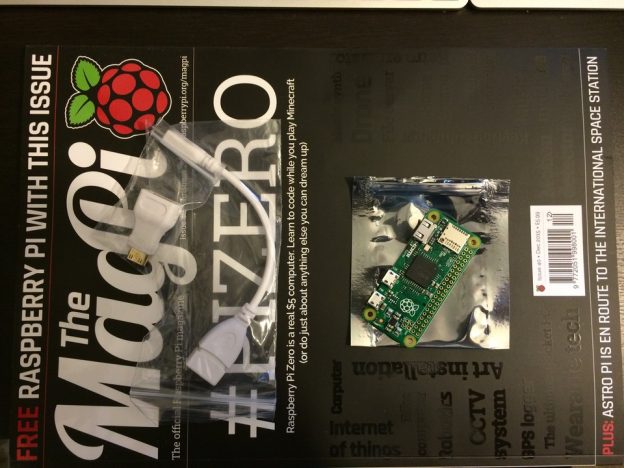This tiny beauty has arrived through my letterbox today. The glorious Raspberry Pi Zero is a fully fledged computer smaller than a credit card. With 1Ghz single-core CPU, 512MB RAM, mini HDMI and USB and a 40 pin GPIO header you won’t run out of ideas of what to do with it. People have created all sort of cool projects using Raspberry Pis. From running container technology like Kubernetes on a Raspberry Pi cluster, to running good old Retro Games on old TV sets.
Why Now?
To be honest this is my first Raspberry Pi. I wasn’t interested in acquiring any of the other Pi models, mainly because of the price and I will explain why. For me a Raspberry Pi is for connecting and experimenting with external electronic modules through the GPIO pins rather than just using it as a mere computer. In particular connecting actuators like stepper motors and sensors. These sensors can read real-world quantities (temperature, humidity, motion, etc…) and feed raw data to the Pi. The software running on the Pi can then pre-process this raw data before sending it to the Cloud (does this sound like IoT?). To do this, most likely you will be connecting and playing with electronic components, hence running the risk of burning the precious Pi. Small mistakes, like not properly grounding a circuit, can result in some smoke and $20 – $35 burnt. Now the $5 Pi Zero is a game changer, with postage costing a sizeable fraction of its price you are better off ordering 10 together!. And it doesn’t matter if you burn or misplace one or two while experimenting, it’s only $5, you can just get a replacement. I believe it will give a massive boast to prototyping IoT ideas.
Enter the Late 90s
I started off my formal education studying Electronics Engineering, before realising that my passion for software was greater and decided to completely switch to Software. It has been years since I last set my hands on a hardware/software interface project.

This 386 Packard Bell Legend form the early 90s was my Raspberry Pi Zero equivalent in 1997!. And I’m not joking, the model was called ‘Legend’ and ‘Elite’ as well. When it was new it probably sold for more than 200 times the Pi Zero price.

I’m expecting a few objections for comparing this monstrous piece of old hardware to the elegant and tiny Pi Zero. After all it’s more than a 1000 times heavier and 30 times slower . Bear with me, if we put size aside, and I know it’s a big ask, and focus instead on capabilities and price. Your dreams of getting a full computer in 1997 with reasonable speed (33Mhz or above) for $5 or less was only going to come true with a 386. During that time people were upgrading to Pentium MMX PCs and getting rid of their old 386s and 486s. It was easy back then getting a 386 almost for free, so if you ended up burning it, getting a replacement wasn’t a big deal.
That 386 was more than sufficient for small projects involving external electronic circuits. At 33Mhz and 8MB of RAM it can comfortably run DOS and Turbo Pascal. Enough to write code that interacts with an external circuit connected through the Parallel Port (used for connecting printers back then). Activating the port though and sending data to it needed Assembly Language and Bitwise operations knowledge. I found some old Turbo Pascal Units I’ve written to interact with the Parallel Port and it’s pretty low-level. Moving data between registers and invoking interrupts:

And here is an example of the circuit schematics I enjoyed drawing. It was simple stuff, but was great fun for filling up spare time:

Size Does Matter
Coming back to size, I was really passionate about these software/hardware interface projects and had a few ideas of adding the Internet to the mix. But having a bulky 386 pumping heat under my feet in a small flat with wires sticking out in a non child friendly way wasn’t going to last for long. This was the reason I gave up on these projects, but I kept the kit hoping for a return one day. Now the Pi Zero ticks all the boxes: size, capabilities and prices. With a Linux flavoured OS and a high level GPIO Python library, I’m hoping to make a come back in 2016 with some IoT project ideas.
Have you been in a similar situation and hoping for a come back on a Pi, or have you been using a Pi recently? Would love to hear your thoughts and experiences.

